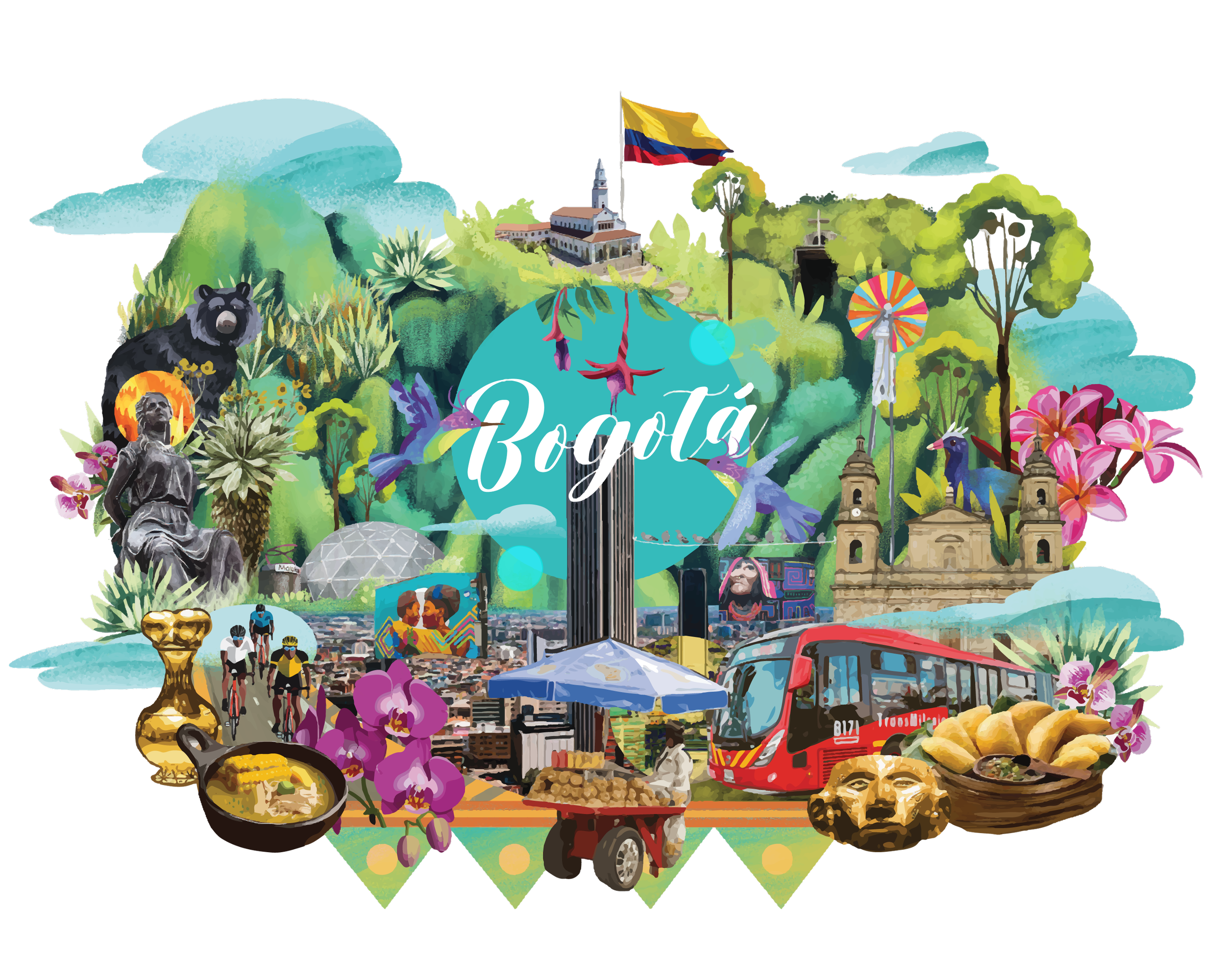Edición Bogotá
Bogotá, the vibrant capital of Colombia, is a city of contrasts where history and modernity coexist harmoniously. Nestled high in the Andes at 2,640 meters above sea level, Bogotá is a melting pot of cultures, ideas, and traditions. Its bustling streets, adorned with colorful graffiti and colonial-era architecture, tell stories of its rich past and dynamic present. From the bustling markets to the serene parks, Bogotá offers a unique blend of urban excitement and natural beauty. This page explores the elements that make Bogotá truly unique through a captivating collage that captures the essence of this remarkable city.
Oso de anteojos: Also known as the Andean bear, the Oso de anteojos is native to the Andean region and symbolizes the rich biodiversity surrounding Bogotá.
Frailejón: This distinctive plant thrives in the páramo ecosystems near Bogotá, playing a crucial role in water regulation and supporting unique wildlife.
Estatua La Pola: The statue of Policarpa Salavarrieta, is a prominent monument dedicated to Policarpa Salavarrieta, a revered heroine of Colombia’s independence movement. This statue stands as a tribute to her courage and contributions, capturing her in a poised and dignified pose. Located in a notable area of Bogotá, it serves as a symbol of national pride and a reminder of the enduring legacy of Colombia’s fight for freedom.
Maloka: An interactive science and technology museum in Bogotá, Maloka represents the city's commitment to education and innovation.
Museo del Oro, Poporo Quimbaya: is renowned for its impressive collection gold artifacts, including the iconic Poporo Quimbaya. This exquisite piece, a ceremonial gold artifact shaped like a cup, is a highlight of the museum's extensive collection. The museum offers a fascinating exploration of Colombia's rich ancient history through its detailed exhibits, showcasing the artistry and craftsmanship of indigenous cultures.
Ciclistas: Bogotá is known for its thriving cycling culture, with extensive bike paths and the famous Ciclovía event, where streets are closed to cars every Sunday.
Graffiti Centro: The graffiti in Bogotá's downtown area is renowned for its artistic and political expressions, reflecting the city's vibrant street art scene.
Ajiaco: This traditional Colombian soup, made with chicken, potatoes, and corn, is a beloved dish that showcases Bogotá's culinary heritage.
Orquídea: The orchid, Colombia's national flower, flourishes in Bogotá's temperate climate, symbolizing the city's natural beauty.
Vendedor Ambulante: Street vendors are a common sight in Bogotá, selling everything from snacks to handmade crafts, adding to the city's dynamic street life.
Graffiti Centro: The graffiti in Bogotá's downtown area is renowned for its artistic and political expressions, reflecting the city's vibrant street art scene.
Transmilenio: Bogotá's rapid bus transit system, Transmilenio, is an integral part of the city's public transportation network, known for its efficiency and scale.
Museo del Oro, Máscara Chamán: Another treasure from the Gold Museum, this shaman mask represents the spiritual and cultural practices of Colombia's indigenous peoples.
Empanada: These savory delicacies, often filled with meat and potatoes, are a popular street food, highlighting Bogotá's diverse culinary offerings.
Catedral Primada: Located in the heart of Bogotá's Plaza de Bolívar, this cathedral is a masterpiece of colonial architecture and a central landmark of the city.
Tingua: The tingua is a colorful bird found in the wetlands surrounding Bogotá, symbolizing the city's connection to nature and wildlife conservation efforts.
Orquidea: The orchid, Colombia's national flower, flourishes in Bogotá's temperate climate, symbolizing the city's natural beauty. This delicate yet resilient flower reflects the rich biodiversity and the vibrant environment of Bogotá. Orchids are a testament to the lush flora that thrives in the region, showcasing the connection between the city and its surrounding natural landscapes.
Zanqueros, Festival de Teatro: Is a captivating performance featuring towering stilt-walkers who dazzle audiences with their impressive height and dynamic movements. Part of the city's renowned theater festival, this spectacle combines creativity, artistry, and theatricality, offering a unique and memorable experience.
Catedral de Zipaquirá: Is an awe-inspiring underground cathedral carved into the heart of a salt mine. Known for its stunning architecture and serene atmosphere, this cathedral is a unique blend of spirituality and craftsmanship. Visitors are captivated by the intricate salt carvings and the profound sense of tranquility that permeates the cathedral, making it a must-visit destination for both its historical significance and its remarkable design.
Monserrate: Overlooking the city, Monserrate is a sacred mountain with a historic church, offering panoramic views and a place for reflection. Accessible by a scenic cable car or a challenging hike, it is home to a prominent basilica and a sanctuary dedicated to the Virgin of Monserrate
Colibrí: The hummingbird, with its iridescent feathers, is often seen in Bogotá's gardens, symbolizing beauty and resilience.
Palomas: Pigeons are ubiquitous in Bogotá, particularly around Plaza de Bolívar, where they add to the lively atmosphere of the city center.
Each element in the collage represents a piece of Bogotá's rich tapestry, bringing together nature, history, culture, and modernity to celebrate the unique character of Colombia's capital.


